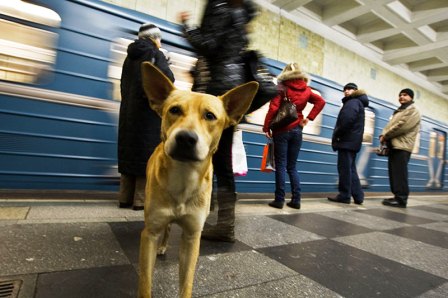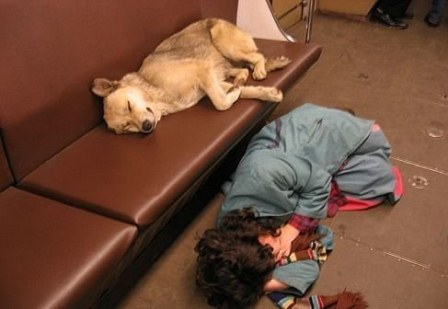The Super Smart Dogs of the Moscow Metro
 Sixty roubles (two dollars) will get you five trips on the Moscow Metro. It’s a good enough deal, but canine commuters still don’t bother to pay.
Sixty roubles (two dollars) will get you five trips on the Moscow Metro. It’s a good enough deal, but canine commuters still don’t bother to pay.
Every morning, like their human counterparts, the stray dogs who make their homes in the industrial areas of the suburbs (big factories, open spaces, and quiet, comfy places to snooze the night away) commute to the nearest subway station and head downtown – to where the food is.
They’ve mastered city life. They know where to get on … and, better yet, they know where to get off. And since they can’t read the signs, they’ve figured out exactly how long it takes for the train to get to their preferred stop. As long as they don’t fall asleep.
Dr. Andrei Poiarkov, of the Moscow Ecology and Evolution Institute, has been studying the remarkable behavior of these dogs. He explains that they often travel together, playing games as they go. “They jump on the train seconds before the doors shut, risking their tails getting jammed. They do it for fun.”
Once they reach their downtown destination, the dogs have to navigate the busy streets. At busy intersections, they’ve figured out the traffic lights. While they can’t apparently tell red from green, they do understand the picture on the green light that means Go.
 And then it’s time for the next level of street smarts: getting the food.
And then it’s time for the next level of street smarts: getting the food.
The best technique for this, the dogs have learned, is to sneak up right behind someone who’s just starting to bite into a shawarma (a meaty fast food wrap) and give a single loud bark. The startled person drops the sandwich … the dog grabs it and runs off.
Careful observation of humans has taught the dogs who’s most likely to be most startled … and most likely to drop their food. They don’t waste time on people who look as though they have their act together. “The main point here is to define who would drop the food scared and who won’t,” explains Dr. Poiarkov. “The dogs are great psychologists they can do it better than us.”
With children, the technique is different: Play cute … find the most sympathetic-looking kids sitting on a bench with their lunch … put your head on their lap … look pleadingly … thank you so much.
The subway routine began about 15 years ago as life in Moscow started changing in the wake of the collapse of the Soviet Union. In the Soviet era, the industrial parts of the city were downtown, but the new capitalists moved them out to the suburbs. So the dogs moved, too, and learned how to commute each day to get to where the food is.
On the way home in the evening, the dogs generally choose the quiet and less full carriages at the front or back of the train. And if they’re traveling in pairs or groups, one dog generally stays awake if the others are snoozing, and wakes them up when they reach their station.
